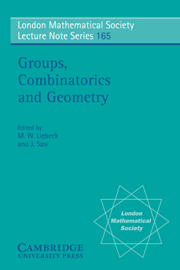Book contents
- Frontmatter
- Contents
- Authors' Addresses
- Introduction
- Part 1 Sporadic groups
- Part 2 Moonshine
- Part 3 Local and geometric methods in group theory
- Part 4 Geometries and related groups
- Part 5 Finite and algebraic groups of Lie type
- 22 Some remarks on the structure of finite subgroups of simple algebraic groups
- 23 Some (almost) multiplicity-free coset actions
- 24 Orbits in internal Chevalley modules
- 25 Subgroups of finite and algebraic groups
- 26 Irreducible representations of finite Chevalley groups containing a matrix with a simple spectrum
- 27 Overgroups of unipotent elements in simple algebraic groups
- Part 6 Finite permutation groups
- Part 7 Further aspects of simple groups
- Part 8 Related topics
24 - Orbits in internal Chevalley modules
Published online by Cambridge University Press: 07 September 2010
- Frontmatter
- Contents
- Authors' Addresses
- Introduction
- Part 1 Sporadic groups
- Part 2 Moonshine
- Part 3 Local and geometric methods in group theory
- Part 4 Geometries and related groups
- Part 5 Finite and algebraic groups of Lie type
- 22 Some remarks on the structure of finite subgroups of simple algebraic groups
- 23 Some (almost) multiplicity-free coset actions
- 24 Orbits in internal Chevalley modules
- 25 Subgroups of finite and algebraic groups
- 26 Irreducible representations of finite Chevalley groups containing a matrix with a simple spectrum
- 27 Overgroups of unipotent elements in simple algebraic groups
- Part 6 Finite permutation groups
- Part 7 Further aspects of simple groups
- Part 8 Related topics
Summary
INTRODUCTION
Let G be a simple, connected algebraic group over an algebraically closed field F of characteristic p ≥ 0. Let P = LQ be a parabolic subgroup of G, where Q is the unipotent radical of P and L is a Levi subgroup of P. Here L acts on Q via conjugation. This induces an L-action on consecutive subquotients of the lower central series of Q. Provided with a suitable F-vector space structure these quotients can be regarded as L-modules. They are called internal Chevalley modules for L.
There exists a unique parabolic subgroup P− of G such that P∪P− = L. We refer to P− as the opposite of P and Q− = Ru(P−) is called the opposite unipotent radical of P. The internal Chevalley modules that occur in Q− are dual to the ones in Q.
In this note we describe some results from regarding the structure of orbits for the action of L on these modules and give some information on the associated stabilizers for arbitrary characteristic.
(1.1) A motivation for this is a result of R. Richardson asserting that L has only finitely many orbits on each of its internal Chevalley modules. We show that there is a close connection between the L-orbits on Q−/(Q−)′ and (P, P)-cosets of G. For details and further information we refer to.
We say that p is a ‘very bad’ prime for G, if p occurs as a structure constant in Chevalley's commutator relations for G. In this situation there are degeneracies in these relations affecting the structure of orbits. We assume throughout these notes that p is not very bad for G.
- Type
- Chapter
- Information
- Groups, Combinatorics and Geometry , pp. 311 - 315Publisher: Cambridge University PressPrint publication year: 1992

